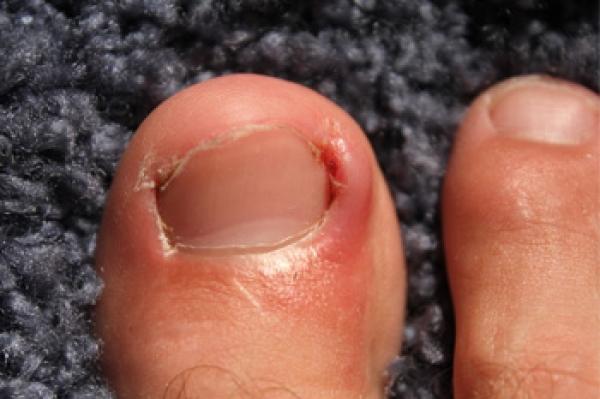Ingrown Toenail

Overview
An ingrown toenail, also known as onychocryptosis, is a common foot condition where the corner or side of a toenail grows into the soft flesh of the toe, causing discomfort, pain, redness, and sometimes infection. This condition primarily affects the big toe, but can occur on any toe.
Types
Ingrown toenails can be classified into three categories based on severity:
1. Stage 1 (Mild): There’s redness and inflammation on the side of the nail.
2. Stage 2 (Moderate): There’s an infection along with pus and granulation tissue formation.
3. Stage 3 (Severe): Chronic infection is seen with increased granulation tissue and hypertrophy (enlargement) of the lateral nail fold.
Causes
Numerous factors contribute to the occurrence of ingrown toenails, including:
– Incorrectly trimmed toenails: Cutting toenails too short or not straight across may cause the nail to grow into the skin.
– Wearing tight shoes: Shoes or socks that squeeze your toes can press the nail into the toe flesh.
– Toe injuries: Injuries may cause your nail to grow abnormally or become embedded in the skin.
– Genetic predisposition: Some people just have naturally curved nails that tend to grow into the skin.
Symptoms
Common symptoms associated with an ingrown toenail include:
– Red, swollen skin next to the nail
– Pain and tenderness in the toe
– Overgrowth of skin around the nail
– Pus-filled blisters
– Severe symptoms might include spreading of the infection to the rest of the toe
Diagnosis
Diagnosis for ingrown toenails is fairly straightforward and usually based on physical examination. Your doctor will inspect your foot to identify redness, swelling, pus, and other signs of an ingrown toenail.
Treatment Options
Treatment options for ingrown toenails mainly depend on the severity of the condition:
– Home remedies: Soaking your foot in warm, soapy water, using over-the-counter pain relievers, and wearing open-toe shoes can help alleviate pain for mild cases.
– Medical treatment: Your physician might partially remove the ingrown portion of your nail or prescribe antibiotics for infection. Severe or chronic cases may require surgery to remove the whole nail.
Living With Ingrown Toenail
Managing an ingrown toenail involves:
– Proper foot hygiene: Keep feet clean and dry, change socks regularly.
– Correct toenail trimming: Always cut nails straight across, not too short and not in a rounded shape.
– Foot-friendly footwear: Wear shoes that fit properly and don’t squeeze your toes.
– Regular check-ups: Inspect your toes for signs of ingrown toenails, especially if you have diabetes or other conditions that cause poor circulation.
When to Seek Help
Seek immediate medical attention if:
– You have severe pain or your symptoms worsen.
– How area around your toenail becomes redder or more swollen.
– Pus or red streaks emerge from your toenail.
– You have underlying health conditions like diabetes, which can affect foot health.
Living with an ingrown toenail is manageable with proper care and awareness. Always consult with a healthcare provider if symptoms persist or worsen.
